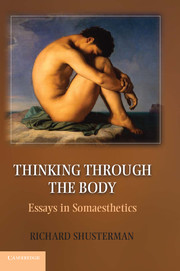Book contents
- Frontmatter
- Contents
- Preface
- Introduction
- Part I Somatic Being, Knowing, and Teaching
- Part II Somaesthetics, Aesthetics, and Culture
- Part III The Arts and the Art of Living
- 10 Somaesthetics and Architecture
- 11 Photography as Performative Process
- 12 Asian Ars Erotica and the Question of Sexual Aesthetics
- 13 Somaesthetic Awakening and the Art of Living
- 14 Somatic Style
- Select Bibliography
- Index
- References
12 - Asian Ars Erotica and the Question of Sexual Aesthetics
Published online by Cambridge University Press: 05 November 2012
- Frontmatter
- Contents
- Preface
- Introduction
- Part I Somatic Being, Knowing, and Teaching
- Part II Somaesthetics, Aesthetics, and Culture
- Part III The Arts and the Art of Living
- 10 Somaesthetics and Architecture
- 11 Photography as Performative Process
- 12 Asian Ars Erotica and the Question of Sexual Aesthetics
- 13 Somaesthetic Awakening and the Art of Living
- 14 Somatic Style
- Select Bibliography
- Index
- References
Summary
I
On a recent visit to Vienna's opulent Kunsthistorisiches Museum, I unexpectedly encountered a genre painting that expressed, with art's most powerful immediacy, a central theme of this chapter. The theme is philosophy's persistent pose of resistance to the seductive aesthetics of sex, and the painting, The Steadfast Philosopher by Gerrit van Honthorst (1592–1656), depicts the attempted seduction of a diligent philosopher by a lovely young woman with fully exposed breasts.
The philosopher in the painting is a manly, moustached figure in the prime of life, seated at his desk with a pile of books to his right and an open book directly in front of him. He has apparently been interrupted in the act of writing, since his right hand holds a feathered-quill pen, while his left arm is raised forward with its fingers spread in a gesture of “stop,” as if to ward off both physically and symbolically the advances and attractions of the seductress who stands near the desk and seems to be removing the wrap covering his left shoulder and tugging gently on the upper sleeve of his shirt. The woman's blue dress and undergarments hang about her waist, while under a matching blue cap (whose feather corresponds nicely to the philosopher's quill), her open-mouthed smile and intent eyes are invitingly directed toward the philosopher, whose gaze is turned away, his lips pursed and his face flushed red (whether from mere embarrassment or other passions). In the chiaroscuro style of the painting, the woman's confident, open, naked posture is bathed in painterly light, while the philosopher's figure contrastingly shrinks defensively toward the shadows. Not only uninterested in engaging in the pleasurable beauties of sexual seduction, he also seems, with his averted gaze, resolutely unwilling to face up to the reality of their attractions – personifying philosophy's willful, fearful blindness to the aesthetics of erotic experience, a blindness that the painter van Honthorst seems to portray with some critical irony.
- Type
- Chapter
- Information
- Thinking through the BodyEssays in Somaesthetics, pp. 262 - 287Publisher: Cambridge University PressPrint publication year: 2012



